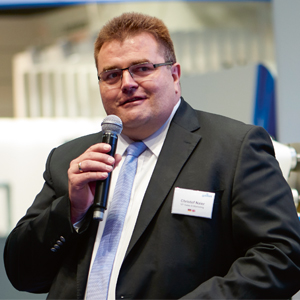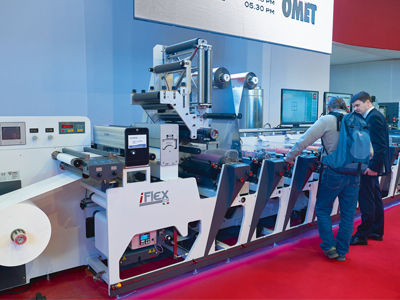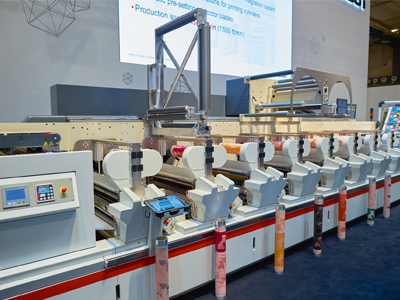The M6 press from Bobst Firenze
The dominant trends in narrow web flexo presses is for faster changeovers and greater flexiblity. By Nessan Cleary.
Over the past year we have seen a lot of emphasis on adding digital capability to narrow web flexo presses, but there have also been plenty of new developments to conventional label presses. To some extent this is driven by the need to make flexo printing more competitive with digital printing. This explains, for instance, the number of presses that now boast short web paths to reduce the time and cost of job changeovers, as well as the success that all vendors report in sales of their entry level presses.
There is a clear trend towards servo drives, with some vendors still offering a choice between line shaft and servo drives, though most of the newer machines have been designed purely to be servo driven, largely because its easier to keep the system in registration. This is particularly true with stretchable materials like flexible films. However, the use of servo drives can add to the cost – anything up to £100,000 – which is why some customers still opt for a line shaft drive.
Another trend is towards wider presses, which can also be used for packaging, whereas narrower presses are really built for label printing. Labels will tend to be used for more dimensionally stable materials such as self-adhesive substratres, whereas packaging is more likely to involve flexible films, explaining why so many modern presses are designed with servo drives and available in widths up to 550 mm or more.
Servo focus
The use of servos varies between vendors, as some use one master servo motor coupled with slave drives, which does help to keep the cost down, but can put more stress on the one motor. However, most vendors will use multiple servo drives and most of the newer machines are fully servo-driven, with servos fitted throughout the press.
Focus Label Machinery provides a good example of this. The company has two distinct narrow width presses, both of which were updated last year for Labelexpo.
The Proflex SE is a modular press that uses servo drives throughout and is aimed at the upper end of the market. It is available in 250 and 330 mm widths with a choice of drying systems, including UV, LED and infra-red, as well as optional chill rollers. The recent updates include a touchscreen operator panel, with the ability to archive jobs for future reference and servo-assisted controls.
The other is the e-Flex, which has been designed as a full-servo press and now gains a twin-servo system for fast set up times. Sales manager Antony Cotton explained the definition of full servo as, ‘All the rotating aspects of the machine are servo-controlled.’
The main difference between the Proflex and the e-Flex is the level of automation. The Proflex offers a choice of servo-driven and non-servo. Mr Cotton added, ‘The Proflex is not truly full servo but there is a servo on each print station.’ He went on to say that servos are only really an advantage if you are working with difficult materials such as thin films, but added, ‘Another advantage is that you have more control in terms of future proofing. If you want to adds auto registration then it’s easier with servos.’
Focus also offers an inkjet print option for both of these, which is based around the same Konica Minolta printheads as the standalone digital machine, the d-Flex. Mr Cotton said that the controls for both presses synchronise the digital elements with the rest of the press.
New and improved
MPS revamped its EF flexo press last year with the new EF Neo model also demonstrated at Labelexpo. It uses a standard EF platform with the addition of a new servo-driven system with improved web tension control. New software has given it closed loop print pressure settings and the Neo also has a large operator control panel and a touchscreen for easier use, which MPS believes will improve the overall productivity of the press.
MPS has worked with several other vendors, which have developed options for the new model. Thus Kocher & Beck has a fully automated Quick-Change die unit, which has two slots so that the die cylinder can be changed without stopping the press, with the impression roller automatically switching between slots. It is designed for fast job changeovers as jobs can be prepared during production. In addition, AVT offers a PrescoNW system to automate pressure settings on the print stations and the press can also be fitted with the new ArcLED hybrid UV drying system from GEW.

Christof Naier, vice president of marketing for Gallus
Mark Andy’s latest flexo press is the P4, announced earlier last summer but officially launched at Labelexpo in September 2015. This is a fully servo-driven press so it can offer auto registration and pre-registration, and the impression settings can be electronically set. It has a rail system so that modules for cold foiling, laminating etc can be mounted easily or removed as needed. It is available in 250, 330 and 430 mm widths.
The P4 has been designed to take older legacy tooling, including that from competitor manufacturers. Paul Macdonald, Mark Andy’s UK sales manager, said that the tooling can add £50-100,000 to the cost of setting up a new press so this is a significant saving for those customers that have built an inventory of older tooling.
LED curing
The Mark Andy P4 can be fitted with the ProLED UV LED curing system. Mr Macdonald said that 90% of customers use UV inks and that people are interested in LED curing but still cautious because of the cost. However, he added, ‘It’s a lot more initial capital investment and there’s a cost element to the inks. But if you think about the power saving and the service costs then there’s a case to be made that the payback is fairly short.’
There are a number of different curing systems around. Last summer, for example, Nilpeter installed an FA-4* complete with a GEW ArcLED curing unit at OPM in Yorkshire. The GEW system uses interchangeable cassettes so that press operators can switch easily between UV LED and conventional mercury arc curing. This should provide a degree of future proofing as customers can switch to UV LED when they are ready. The system includes a Rhino power unit which overcomes one of the problems in dual curing set ups by automatically switching power supplies from the DC used for LEDs to the AC required for mercury arc.
Omet has taken a slightly different approach, using an LED curing system from the American company AMS, which Omet opted for after seeing it retrofitted to a Varyflex V2 press at a customer site in Italy. The system uses AMS’s XP Series LED lamps, which generate up to 25 W/cm2 each. These are solid-state modules used with a water-based chilling system. Up to 20 of these can be joined together and used on narrow and medium web presses and they can also work alongside conventional UV lamps so that it is possible to switch between the UV and LED curing.
Omet has also developed a touchscreen control that has been integrated to its presses to monitor the curing and control the settings. The LED curing option was demonstrated at Labelexpo on a hybrid XFlex X6 Digital, a 430 mm flexo press that also incorporates digital inkjet printing. The company also sells a version of the X6 with flexo and offset units, which has now gained a quick change die-cutting system – essentially a trolley that can hold two separate dies to make it easier to switch them over without special lifting equipment.
The show in Brussels also saw the launch of Omet’s new iFlex PS label press. This is an entry level 370 mm wide UV flexo press that is said to be very easy to work with. It has a short 1.3 metre web path to reduce makeready waste, but can be configured with a longer path for use with water-based inks. It is a shaft-driven press, with a directly driven impression cylinder and uses one gear per print unit on the plate cylinder to reduce gear backlash.

This new iFlex PS label press from Omet is 370 mm wide and features a short web path
The manufacturer has developed a system of laser pointers, which it calls iLight, to locate each unit for registration and to show the mounting position for each plate, the idea being to help the operator work faster. Each unit also has a camera to help set registration, which can be seen through a centrally mounted iVision monitor. Omet claims that these features give the press the sort of quick set up and low waste that is normally associated with a fully servo-driven press, but at a lower cost.
Further options include hot air drying as well as cold foil, screen printing and UV lamination and it also comes with the same quick change die-cutting system as the X6.
Nilpeter’s most recent flexo press is the FA-4*, a 420 mm wide servo-driven press that has been designed to handle both filmic materials and self-adhesive labels (though Nilpeter still supplies a standard version of the FA-4). The print units are milled from a single pre-fabricated element, which allows for better tolerance and improved performance while simultaneously cutting the costs. It is a combination flexo press that can accommodate various print processes such as offset or gravure, as well as options for effects such as foiling and embossing. Nick Hughes, managing director of Nilpeter UK, said, ‘Everything works off an iPad so there’s very little actual mechanical engineering.’
All change
Last year saw two of the major suppliers of label presses taken over, as other vendors expanded into the labels and packaging sector. Gallus retains its name and some independence despite its takeover by Heidelberg, while Nuova Gidue joined Bobst Group and has been renamed Bobst Firenze.
Last year Bobst showed off two new presses, both of which can be set up for fast changeovers without stopping the press. The M4 has a maximum print width of 370 mm and is aimed at the label market. It takes paper, light cartonboard and film up to 20 microns. It is a semi-servo driven machine and runs at up to 180 m/min. It is a combination press that can take flexo, offset, screen and digital print units. The M6 is larger with a print width of 630 mm and so is really targeted at the flexible packaging market. It runs at up to 200 m/min.
Bobst is continuing its work on the Revo project, which brings together several suppliers to create a flexo press solution that offers the cost-effective short runs and fast changeover flexibility that we normally associate with digital printing. This was demonstrated at the Brussels show on the new M6 with automatic turret unwinder and rewinder with plate cylinders changed directly on the press, and one job following the last automatically without stopping the press.
The company also unveiled a new semi-rotary die station on the M6. At the heart of the Revo concept is the adherence to a fixed seven colour inkset. The idea is that this delivers a wider colour gamut, good enough for the majority of jobs. But crucially, it uses the same inks for every job so there is no time wasted changing spot colours between jobs.

This new iFlex PS label press from Omet is 370 mm wide and features a short web path
However, although most vendors report some interest in extended colour gamut inks, they also say that press configurations have become more complex as label printers try to differentiate themselves from their competitors.
Christof Naier, head of sales and marketing for Gallus, said that this has been particularly noticeable over the last two years, adding, ‘People are ordering more colours. The average was six to seven colours but now it’s 10 so the presses are getting more sophisticated.’
Gallus has recently overhauled its flagship RCS430 press. This 10-year old model has been brought up to date with the same modern control platform that has already been introduced on the ECS and EMS series. This allows for faster job changeovers and should help to improve overall productivity.
As well as flexo, the RCS430 also offers offset and screen printing plus hot foil embossing units, which can be added anywhere on the press. Mr Naier said that its main advantage is its flexibility, adding, ‘We can exchange all printing stations from flexo to offset, for example, within minutes.’
Gallus has also improved the ECS340 press. This is designed around a very short web path to reduce makeready costs, having just 1.1 metres between printing units. It also uses sleeves and chambered doctor blades for faster set-up times. At the end of last year, the company introduced a new matrix stripper and a new UV flexo unit, as well as the unwinder and rewinder units being upgraded.
The ECS press also forms the basis of the hybrid DCS340, developed with Heidelberg and using Fujifilm printheads. This uses Heidelberg’s Prinect software and it appears that Gallus is looking at using some of the Prinect modules in its presses at some point in the future. Naturally, the DCS340 can also use the full range of conventional modules developed for the ECS340.
Conclusion
There is no single solution for all needs. At one end of the spectrum, there is clearly still a demand for relatively inexpensive, easily serviced non-servo narrow web presses up to 330 mm for the label market. But there is clearly an ongoing trend towards packaging that is driving the demand for wider servo-driven presses, and a further trend toward shorter runs that is leading to both digital presses and faster job changeovers on flexo. It is already obvious that the next big theme will be the adoption of UV LED curing, which is likely to become much more widespread over the next two to five years as more of these inks become available.






